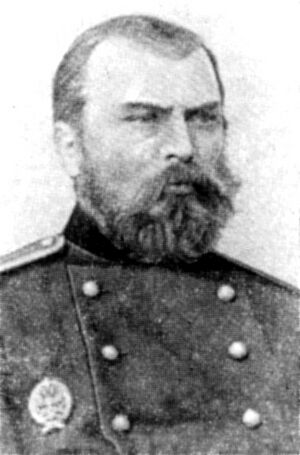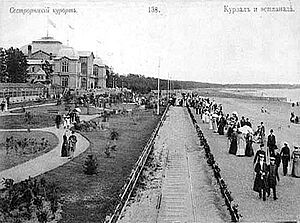Fyodor Pirotsky facts for kids
Fyodor Apollonovich Pirotsky was a smart Russian engineer with Ukrainian roots. He is famous for inventing the world's first railway electrification system and the very first electric tram. Even though his inventions weren't used widely in Russia right away, Pirotsky met with Carl Heinrich von Siemens. This meeting helped Siemens later create the first regular electric tram line in Berlin.
Contents
Early Life and Education
Fyodor Pirotsky was born in 1845 in a place called Lokhivtsa, which was part of the Russian Empire. Today, this area is in Ukraine. His family came from Cossack ancestors.
Pirotsky studied in Saint Petersburg. He graduated from two military schools: the Konstantinovsky Cadet Corps and the Mikhailovskaya Military Artillery Academy in 1866. After finishing school, he worked in Kiev with the Fortress Artillery. While in Kiev, Pirotsky became good friends with a famous Russian electrical engineer named Pavel Yablochkov. This friendship made Pirotsky very interested in how electricity could be used.
Pioneering Electric Transport
In 1871, Pirotsky moved back to Saint Petersburg. He started working on many new ideas. In 1874, he began doing experiments on a field in Saint Petersburg. By 1875, he had created electrically powered railway cars. He tested these cars on the Sestroretsk railway's Miller's line. This was near a station called Miller's pier.
How His Electric Railway Worked
The electricity for his railway cars traveled about one kilometer. In his design, the metal rails were connected to a special machine called a Gramme generator. Both rails were kept separate from the ground. One rail carried the electricity to the car, and the other rail carried it back. This was a very new way to power trains!
The First Electric Tram
In 1880, Pirotsky took a regular city tram that was pulled by horses and changed it to run on electricity. On September 3, 1880, this amazing new electric tram started carrying people in Saint Petersburg. Some people who owned the horse trams were not happy, but the electric tram was a big step forward! These experiments continued for about a month. Many historians believe this was the very first electric tram in the world.
Pirotsky didn't have enough money to keep his experiments going. However, his work sparked a lot of interest in electric trams all over the world. One important person who met Pirotsky was Carl Heinrich von Siemens. Siemens was very curious and asked many questions about Pirotsky's work. Just one year later, in 1881, the Siemens brothers began making their own electric trams. The first permanent electric tram line using Siemens' trams opened in Berlin in 1881. The first permanent tram line in the Russian Empire opened in Kyiv in 1892.
Later Life and Legacy
Sometimes, talented people are not fully recognized during their lifetime. Pirotsky faced some challenges. Despite his famous inventions, he was sent to a military fortress. In 1888, he was dismissed from his military service early, with the rank of colonel.
Pirotsky continued to work as an artillery officer for the Imperial Russian Army. He installed the first underground electric cable in Saint Petersburg in 1881. This cable moved electricity from a cannon factory to a military school. He also had ideas for making a central system to produce electricity for the whole city using underground cables. He even designed new types of furnaces for factories and bakeries.
In 1888, he retired as a colonel. He lived on his military pension in a town called Alyoshki (now Oleshky, Ukraine). He passed away there in 1898. When he died, he didn't have any money, so his burial was paid for by using his furniture as a guarantee.



